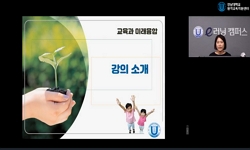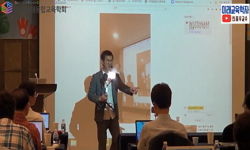The framework of an era is the basis for setting the direction of politics, society, economy and education. What is the framework for explaining the contemporary era? The researcher intend to put the post-human era in that frame. Therefore, this study...
http://chineseinput.net/에서 pinyin(병음)방식으로 중국어를 변환할 수 있습니다.
변환된 중국어를 복사하여 사용하시면 됩니다.
- 中文 을 입력하시려면 zhongwen을 입력하시고 space를누르시면됩니다.
- 北京 을 입력하시려면 beijing을 입력하시고 space를 누르시면 됩니다.
https://www.riss.kr/link?id=A106491946
- 저자
- 발행기관
- 학술지명
- 권호사항
-
발행연도
2019
-
작성언어
Korean
-
주제어
Posthuman Era ; Education ; The human ; Convergence ; Creative Knowledge ; 포스트휴먼 시대 ; 교육 ; 인간 ; 융합 ; 창조적 지식
-
등재정보
KCI등재
-
자료형태
학술저널
-
수록면
269-279(11쪽)
-
KCI 피인용횟수
0
- DOI식별코드
- 제공처
-
0
상세조회 -
0
다운로드
부가정보
다국어 초록 (Multilingual Abstract)
The framework of an era is the basis for setting the direction of politics, society, economy and education. What is the framework for explaining the contemporary era? The researcher intend to put the post-human era in that frame. Therefore, this study will examine the characteristics of the posthuman age, which is being discussed, and then discuss the direction and value of education. The representation of the present age is condensed into two characteristics. First, human nature is threatened. This is due to the movement of scientific and technological development to upgrade the machine to human status according to the desire to go beyond human limits. And second, the rate of response between individuals and groups. This means that large societies do not immediately respond to changes in the times, while individuals experience and accept change quickly. In this age change, 'knowledge' is used as 'the source of creative knowledge' rather than the object of consumption. Therefore, the role required in the realm of education is to provide an opportunity for experience in the posthuman era and to promote thinking to understand the relevance between the realms. In conclusion, the direction and value of education that we should pursue should be directed towards 'the human', not as a machine, and we should end up using the creative knowledge through the convergence between each domain as a subjective human.
국문 초록 (Abstract)
한 시대의 틀은 곧 정치, 사회, 경제, 교육의 방향을 설정하는 기준이 된다. 그렇다면 ‘현대’ 시대를 설명하는 틀은 무엇인가? 논자는 ‘포스트휴먼 시대’를 그 틀에 놓고자 한다. 그래서 ...
한 시대의 틀은 곧 정치, 사회, 경제, 교육의 방향을 설정하는 기준이 된다. 그렇다면 ‘현대’ 시대를 설명하는 틀은 무엇인가? 논자는 ‘포스트휴먼 시대’를 그 틀에 놓고자 한다. 그래서 본 연구에서는 현재 논의되고 있는 포스트휴먼시대가 가진 특징을 살펴본 후 교육이 추구해야 할 방향 및 가치를 논의할 것이다. 먼저, 현 시대의 표상은 두 가지 특징으로 압축된다. 첫째, 인간의 본질이 위협받고 있다는 것이다. 이것은 인간의 한계를 뛰어 넘고자 하는 욕망에 따라 기계를 인간의 지위로 격상시키고자 하는 과학기술 발달의 움직임에 기인한다. 그리고 둘째, 개인과 집단 간 반응 속도의 차이이다. 이것은 거대한 사회는 시대의 변화에 즉각적으로 반응하지 못하는 반면, 개인은 빠르게 변화를 체험하고 받아들이는 것을 의미한다. 이러한 시대적 변화 속에서 ‘지식’은 소비의 대상이 아닌 ‘창조적 지식의 원료’로서 활용되며 계속해서 재구성된다. 따라서 교육의 영역에 요구되는 역할은 포스트휴먼 시대에 대한 경험의 기회를 제공하고, 각 영역 간의 관련성을 파악할 수 있도록 사고를 촉진하는 것이다. 결론적으로, 우리가 추구해야 하는 교육의 방향과 가치는 기계가 아닌 ‘인간’을 향해야 하며 주체적 인간으로서 각 영역 간의 융합을 통해 창조적 지식을 활용해 나가야 할 것이다.
참고문헌 (Reference)
1 김소영, "포스트휴먼에 관한 존재론적 해석 : <공각기동대>, <이노센스>, <아바론>을 중심으로" 한국영상문화학회 (33) : 34-61, 2018
2 정연재, "포스트휴머니즘 행복론에 대한 비판적 고찰" 한국윤리학회 1 (1): 317-342, 2018
3 우정길, "포스트휴머니즘 인간관에 대한 비판적 성찰: 기능과 욕망의 관점에서" 한국교육철학학회 40 (40): 75-99, 2018
4 최민자, "포스트모던 세계와 포스트휴먼 그리고 트랜스휴머니즘" 동학학회 (44) : 129-179, 2017
5 최용성, "트랜스휴머니즘 시대의 약리학적 도덕교육방안" 한국윤리교육학회 (45) : 101-146, 2017
6 정연재, "존엄성 개념의 명료화를 통한트랜스휴머니즘의 비판적 고찰" 한국윤리학회 1 (1): 137-162, 2015
7 이창익, "인간이 된 기계와 기계가 된 신: 종교, 인공지능, 포스트휴머니즘" 종교문화비평학회 31 (31): 209-254, 2017
8 박인찬, "사물의 시대에 오신 것을 환영함: 포스트휴머니즘의 새 접근" 한국현대영미소설학회 24 (24): 183-202, 2017
9 조부민, "『테스』를 통해 본 포스트휴먼 시대의 인간" 한국영미문화학회 18 (18): 189-213, 2018
10 I. Persson, "Unfit for The Future: The Need for Moral Enhancement" Hawoo 2015
1 김소영, "포스트휴먼에 관한 존재론적 해석 : <공각기동대>, <이노센스>, <아바론>을 중심으로" 한국영상문화학회 (33) : 34-61, 2018
2 정연재, "포스트휴머니즘 행복론에 대한 비판적 고찰" 한국윤리학회 1 (1): 317-342, 2018
3 우정길, "포스트휴머니즘 인간관에 대한 비판적 성찰: 기능과 욕망의 관점에서" 한국교육철학학회 40 (40): 75-99, 2018
4 최민자, "포스트모던 세계와 포스트휴먼 그리고 트랜스휴머니즘" 동학학회 (44) : 129-179, 2017
5 최용성, "트랜스휴머니즘 시대의 약리학적 도덕교육방안" 한국윤리교육학회 (45) : 101-146, 2017
6 정연재, "존엄성 개념의 명료화를 통한트랜스휴머니즘의 비판적 고찰" 한국윤리학회 1 (1): 137-162, 2015
7 이창익, "인간이 된 기계와 기계가 된 신: 종교, 인공지능, 포스트휴머니즘" 종교문화비평학회 31 (31): 209-254, 2017
8 박인찬, "사물의 시대에 오신 것을 환영함: 포스트휴머니즘의 새 접근" 한국현대영미소설학회 24 (24): 183-202, 2017
9 조부민, "『테스』를 통해 본 포스트휴먼 시대의 인간" 한국영미문화학회 18 (18): 189-213, 2018
10 I. Persson, "Unfit for The Future: The Need for Moral Enhancement" Hawoo 2015
11 D. Weinberger, "Too Big to Know" Leader’s Books 2014
12 R. Kurzweil, "The Singularity is Near" Penguin Books 2005
13 R. Bridotti, "The Posthuman" Acanet 2016
14 S. Arbesman, "The Half-Life of Facts" Books on Wednesday 2014
15 Sangkyu-Shin, "The Future of Homo-Sapience" Acanet 2014
16 D. J. Harraway, "Simians, Cyborgs, and Woman : The Reinvention of Nature" Routledge 1991
17 P. Freire, "Praxis, We Male the Road by Walking" Achchimyisul 2006
18 The Book of Korea Post Human Research Institute, "Posthumans of the Age of Humanity" Acanet 2016
19 N. Bostrom, "Human Genetic Enhancements : A Transhumanist Perspective" 37 (37): 493-506, 2003
동일학술지(권/호) 다른 논문
-
뇌교육 기반 인성프로그램이 초등학생의 자아존중감과 친구관계 향상에 미치는 효과
- 사단법인 인문사회과학기술융합학회
- 김창규
- 2019
- KCI등재
-
관상동맥 조영술을 받는 대상자에게 음악요법이 미치는 효과
- 사단법인 인문사회과학기술융합학회
- 곽선경
- 2019
- KCI등재
-
간호대학생이 경험한 무례함, 임상실습스트레스가 진로정체감에 미치는 영향
- 사단법인 인문사회과학기술융합학회
- 양희모
- 2019
- KCI등재
-
사회복지 교과목의 문제중심학습(PBL) 방식 적용에 대한 탐색적 연구 -사회복지조사론의 욕구조사계획 수립 과정을 중심으로-
- 사단법인 인문사회과학기술융합학회
- 강동훈
- 2019
- KCI등재
분석정보
인용정보 인용지수 설명보기
학술지 이력
| 연월일 | 이력구분 | 이력상세 | 등재구분 |
|---|---|---|---|
| 2020 | 평가예정 | 신규평가 신청대상 (신규평가) | |
| 2019-12-01 | 평가 | 등재 탈락 (기타) | |
| 2019-01-01 | 평가 | 등재학술지 유지 (계속평가) |  |
| 2016-01-01 | 평가 | 등재학술지 선정 (계속평가) |  |
| 2014-01-01 | 평가 | 등재후보학술지 선정 (신규평가) |  |
학술지 인용정보
| 기준연도 | WOS-KCI 통합IF(2년) | KCIF(2년) | KCIF(3년) |
|---|---|---|---|
| 2016 | 0.33 | 0.33 | 0.32 |
| KCIF(4년) | KCIF(5년) | 중심성지수(3년) | 즉시성지수 |
| 0.33 | 0.32 | 0.407 | 0.14 |




 KCI
KCI 스콜라
스콜라






